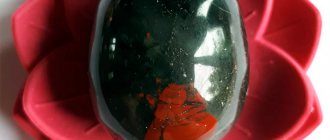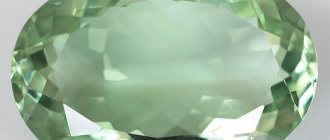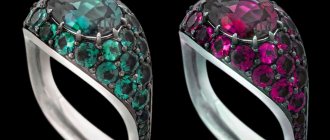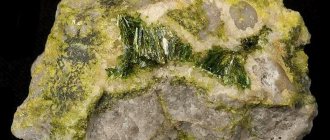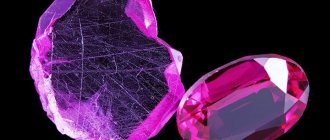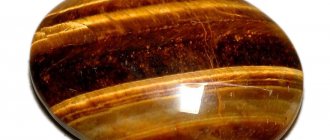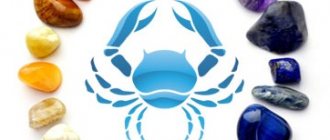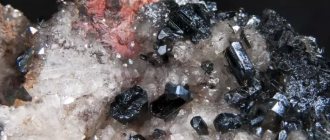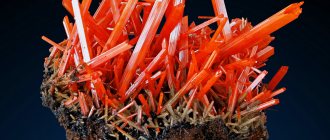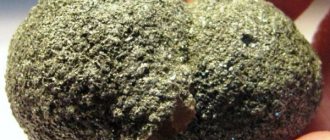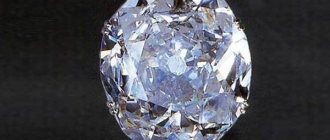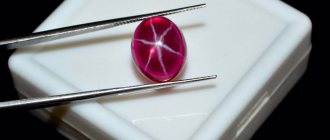In this article we will talk about the properties of heliotrope. Having learned more about its meaning for people of different professions and zodiac signs, you can decide for yourself whether it is worth buying it. You will also learn about the history of this amazing gem and how to spot a fake.
History and origin
Heliotrope, which received other names for its specific appearance - “blood stone” and “blood jasper”, is of Asian origin. From Ancient India and Bukhara, it came to Europe about two thousand years ago, where it was revered as a gem associated with Christ and St. Stephen, who suffered execution by stoning.
Bloody Jasper
According to Middle Eastern and European legends, the characteristic red (from scarlet to dark speckled) spots with which this mineral is dotted are drops of the congealed blood of the crucified Christ. Thanks to this, heliotrope became the “trademark” of European mystics and theologians for many centuries.
Pectoral crosses with it are still popular among priests, both Catholic and Orthodox. Various items of church utensils were also often made from it.
The meaning of heliotrope stone
Heliotrope photo of the stone
The peculiar natural “design” secured the name and glory of the “blood stone” for the gem.
Often uninitiated people confuse it with the name “bloodstone”, which actually belongs to red iron ore - hematite.
However, there are many legends explaining the nature of heliotrope spots. The most famous of them is associated with the torture of Christ.
It is believed that this mineral, originally monochromatic, was found in abundance at the site where the terrible crucifixion took place.
And the brown inclusions that later appeared on the green stones are splashes of the blood of Jesus. It is not without reason that the stone is used to decorate the decorations of church servants and temple utensils.
But the science of mineralogy does not believe myths and explains the mysterious spots of the stone differently.
Heliotrope itself is an opaque variety of cryptocrystalline silica, most often a chalcedony subtype of dense quartz.
The impurities that create the unique pattern are chalcedony inclusions, iron oxides and hydroxides of other minerals.
Physicochemical characteristics
The hardness of the mineral is above average, up to 7 on the Mohs scale. It is a complex mineral, the basis of which is silicon oxide, but inclusions of other minerals, in particular chalcedony, can be found. The closest relative of heliotrope is quartz.
| Formula | SiO2 |
| Color | Dark green, greenish blue with bright red spots |
| Shine | Glass pale shine |
| Transparency | Opaque |
| Hardness | 6,5 — 7 |
| Cleavage | Absent |
| Kink | Uneven |
| Density | Up to 2.58–2.64 g/cm3 |
Video about the stone
The video will complement the information about the bloodstone, which has many names. The author of the video talks about the amazing properties of the mineral and its areas of application. Much attention is paid to its mystical properties.
The mineral, so beloved by both esotericists and representatives of religious faiths, deserves respect. The properties of heliotrope have been tested for centuries. It is endowed with such powerful power that it is impossible to wear it all the time. This only confirms once again the uniqueness of the bloody stone, which preserves the memory of Jesus himself.
Place of extraction
Currently, heliotrope deposits are being actively developed in the Urals and in the USA - the states of California and Wyoming. There is a small deposit in Bukhara (Uzbekistan). The stone is also mined in Australia, Namibia, Egypt, Armenia, China and India, although the richest and oldest Indian deposit of “blood jasper”, located in Calcutta, has already been exhausted.
Place of Birth
The most ancient heliotrope mines were located in Egypt and Calcutta, but at the moment their reserves are completely depleted.
Modern deposits of this mineral are located in Russia (region of the Ural Mountains). The USA, India and Australia are also active exporters of stones to world markets. Minor deposits of heliotrope rocks can also be found in China, southern Brazil and Central Asia.
Be sure to see: All about turquoise
Varieties and colors
The term “heliotrope” is more jewelry than chemical. This word can refer to a wide range of stones that are similar in appearance and physical properties, but different in chemical nature. A specific instance of a processed stone may be more related to quartz, or perhaps to chalcedony or jasper, of which it is considered a brother due to its appearance.
The stone looks quite beautiful. It is recognized by its greenish or bluish main color with numerous scarlet, red, burgundy and orange patches, located randomly. They may appear as spots, blotches or streaks. Darker inclusions of hematite are also acceptable.
Incredibly beautiful heliotrope pattern
“Bloody jasper” with yellow splashes is called plasma.
There is no clear classification of heliotropes according to color scheme. Like jasper, with which it is often confused, the gem can play with any colors, but among them there is always green or ultramarine and red. Shades of the main color can be very diverse - from grayish swamp to deep blue.
This is unusual: when looking at some faceted heliotropes, an association arises with photographs of distant galaxies taken through electronic telescopes. Clusters of scarlet, orange and yellow dots on a greenish-blue background turn out to be surprisingly similar in appearance to photographs of stellar nebulae.
This gem is opaque and, after polishing, acquires an almost glassy sheen. In the light, the color may change slightly and “play.”
Heliotrope should not be confused with bloodstone. The latter is distinguished by its rich red color, which can have shades from brown to dark burgundy, the color of dried venous blood. The main external sign of heliotrope is the combination of green or blue with red or yellow.
Green heliotrope with red and yellow splashes
Price of jewelry with heliotrope
Semi-precious gems are ubiquitous, so prices for stones, jewelry with them, or household and design items are very reasonable. The cost of jewelry with heliotrope is determined based on criteria such as:
- Quantity, processing method and multiplicity of stones;
- Color;
- Frame material;
- Mass character of the party;
- Exclusivity of design;
- Age of decoration.
Prices for tumbled stones and uncut cabochons range from 50 rubles per unit. The dimensions of the stone do not exceed 2 centimeters. Stones from 2 to 3 cm cost 70-80 rubles per unit and so on. Serial products can be purchased in jewelry stores for several thousand rubles. But the cost of an exclusive item from fashionable and popular brands or an antique item will be in the tens, or even hundreds of thousands.
Medicinal properties
In lithotherapy, heliotrope is used as a means that can influence blood flow. It is believed that it can improve hematopoiesis, normalize blood pressure and all related processes in the body, primarily digestive. In the Middle Ages, heliotrope - whole or crushed - was often used to stop bleeding from open wounds.
In addition, “bloody jasper” has a beneficial effect on diseased kidneys and can contribute to the painless and most bloodless passage of stones from the bladder. In women, this stone can reduce pain during menstruation, and, in some cases, normalize the menstrual cycle.
Silver pendant with green heliotrope
Silver ring with red heliotrope
The third of the fundamental medicinal properties of heliotrope is its incompatibility with toxins. Heliotrope is credited with the ability to remove toxic substances and toxins from the body - decay products of useful substances processed by the body. Wearing heliotrope increases resistance to infectious diseases, reduces the risk of infection, and gives new strength to the immune system.
The fourth healing property of the stone is its beneficial effect on the psyche. It increases resistance to depression, gives strength and energy, and increases mental performance. "Bloodstone" is a focus of energy. It is recommended to be worn by those who have a need for increased energy consumption - very busy people both physically and mentally (athletes, entrepreneurs, teachers, senior managers) - or vice versa, people with moderate energy consumption, but very little personal energy.
Heliotrope optimizes energy consumption, but if there is no place to realize it, a person may suffer from hyperactivity and excess strength.
Blood Jasper – green heliotrope with red flecks
Areas of use
The main area of application of the mineral is jewelry and ornaments. Jewelry, interior items, and church paraphernalia are made from it. A distinctive feature of the products is their low cost.
Zodiac sign
Astrologically, heliotrope is associated with several planets at once: the Moon, Venus and Saturn. Hence its duality: just as it promotes a state of balance in its owner, it can also cause harm; helps achieve goals, but acts exactly the opposite if the owner’s aspirations reach the point of fanaticism.
- For Virgos, Sagittarius and Cancers, heliotrope helps to move up the career ladder and grow as a person, but can interfere with personal happiness.
- For Aries, wearing this stone as an amulet stimulates the birth of new ideas.
- Scorpios need to use the talisman with caution: it will reduce their natural aggressiveness, but can hinder career and sports success.
Astrologers do not recommend wearing it to Aquarius, Leo and Taurus, because... it negatively impacts their lives.
Medicinal properties
Lithotherapists have always considered heliotrope a special healing stone, associating it with blood and its effect on its properties. Thus, the famous 17th century scientist Robert Boyle in his “Essay on the Origin and Power of Precious Stones” mentions one gentleman who was worried about constant nosebleeds. The scientist sent him heliotrope, advising him to wear it as a pendant; and while the patient did this, the disease subsided. But when I took it off, a relapse occurred. At the same time, an incident occurred with a lady who lost consciousness from blood loss and came to her senses only thanks to heliotrope. Boyle concluded that in these cases the bleeding stopped due to the cold surface of the mineral.
Modern lithotherapists note the positive effect of the energy of bloody jasper on the entire body. It is used for:
- treatment of the cardiovascular system;
- saturating tissues with useful elements;
- regulation of metabolism;
- maintaining immunity in case of viral diseases;
- treatment of atherosclerosis;
- relieving menstrual pain;
- cleansing the liver, intestines, bladder;
- improvement of the condition in diseases of the urinary tract, gynecological diseases, intoxication of the body;
- treatment of psychological infertility, depression and nervous tension;
- stopping bleeding, increasing hemoglobin levels;
- restoration of lost strength and consciousness. For this, the mineral is respected by athletes, for whom it helps maintain strength, maintain composure and concentration.
Heliotrope has a calming effect on the owner: eliminates fears, anxiety, and regulates sleep.
Considering the mineral is useful for eye diseases. Its green color has a positive effect on vision and relieves fatigue.
For snake bites, the poison can be neutralized with bloody jasper powder mixed with honey. The same recipe is effective for tumors and purulent abscesses.
Magic properties
From time immemorial, heliotrope was valued as a special stone by alchemists and magicians, who attributed to it the gift of making the sun blood red and causing natural disasters. Damigeron's old treatise notes that it can be used to predict the weather.
In the papyri of Ancient Egypt there is information about the greatest talisman - heliotrope, the owner of which will be able to have everything he wants. The Egyptians endowed him with the ability to open all doors and destroy walls.
Ancient Greek and Roman emperors revered it as a powerful amulet and were in awe of it. There was a belief that if you carve a dove on heliotrope, such a talisman would turn a sick person into a healthy one, out of a cruel person into a soft one, and out of an unhappy person into a happy one.
Medieval magicians tried to strengthen their energy by constantly wearing rings and bracelets with bloody jasper. Alchemists believed that they would understand the Universe with its help, considering the mineral to be a conductor of energy between the Earth and the Cosmos.
In Dante's poem "The Divine Comedy" it is mentioned that the stone can protect against poisoning and grant its owner invisibility.
The Christian Church considered the mineral as a material for decorating and creating church paraphernalia: bowls, vessels, candlesticks, crosses. The favor of the clergy towards the stone was explained by the identification of the red spots on it with the blood of Christ.
Wearing bloody jasper, according to magicians, makes a person more active, energetic, helps to concentrate on overcoming obstacles and solving complex problems; develops abilities in psychology and philosophy, foreign languages, medical sciences.
Those who, with the help of a talisman, decide to gain power and satisfy their ambitions risk losing their minds and losing property.
Heliotrope is not suitable as an amulet for lazy and indecisive people. It promises them only resentment and disappointment.
It is also interesting that the mineral will help only in light magic and good endeavors. If its owner says evil words to an enemy, sends a curse, then it can turn against him. Unknowingly, a person can jinx himself. This is the other side of heliotrope.
Decorations
Jewelers use this semi-precious stone not only to make jewelry, but also to create various items - bowls, boxes, ashtrays, etc. There are several Faberge eggs made from this material. One of the copies with a carved silhouette of the cruiser “Memory of Azov” is kept in the Armory Chamber of the Moscow Kremlin.
The faceted mineral is found in rings, earrings, brooches, and pendants. It looks especially impressive when framed with:
- silver;
- brass;
- gland;
- nickel plated steel.
These metals help enhance its effect.
Products made from bloody jasper are very massive and rough, not for everyone. But they always look impressive.
Among men in the 17th – 19th centuries, large signet rings with a heliotrope insert with a family coat of arms carved on its surface were popular. Such jewelry was carefully kept as a family treasure and passed on by inheritance. The most interesting specimens are in large private collections.
It is recommended to wear a ring with heliotrope on the index or ring finger. The brooch should be located in the center of the chest, and the pendant should be located at the level of the solar plexus.
Such jewelry is not very expensive, with the exception of stones formed in ancient eras.
The price of an ancient mineral increases several times: taking into account the jewelry work and the brand, a set of a necklace and bracelet can cost about $2,000.
Every month the stone needs to be “discharged” and “charged” with energy at least once. To do this, keep it under running cool water, eliminating accumulated negative energy. Then they leave it in direct sunlight, thereby charging it with the energy of the sun.
Household use
Heliotrope itself is not used for domestic purposes. Products made from it are popular. Beautiful and unusual boxes, bowls, vases, ashtrays, figurines look great in the interior. According to the teachings of Feng Shui, this mineral synthesizes the positive energy of growth and vitality. Therefore, it is recommended to keep products made from it in the nursery, office and living room in the southeastern and eastern zones, which are responsible for success and family well-being.
Magic properties
Due to its origin, this mineral gained fame as one of the most mystical stones, a favorite of medieval magicians and alchemists. The first believed that a ring, bracelet or pendant with it could be an additional source of energy that increases the power of the magician. The latter considered heliotrope a “stone of knowledge”, giving both a desire to comprehend new things and mental abilities that allow them to master a lot of information. Astrologers associate heliotrope with Mars.
Alchemists, scientists, mystics and princes of the Church unanimously agreed that heliotrope, on the one hand, increases intellectual performance, gives strength, determination and activity, but on the other hand, it can turn a person into a fanatic obsessed with one global idea. The "Blood Stone" pushes a person towards a chosen goal with the persistence of a tractor, but this is achieved by "diverting" energy from other areas. The gem takes it from his personal life, from his family, emotional attachments and personal weaknesses.
Heliotrope - blood stone
Initially, it will give determination to a weak person, although it can disrupt, for example, harmony in the family, but it can turn a naturally strong person into a walking battering ram - and at the same time drive him crazy. Wearing heliotrope is strictly unacceptable for those who have not decided on a life goal - there is a risk of finding themselves in a final dead end and at the same time in severe depression. “Bloody Jasper” can have a detrimental meaning for an indecisive person.
People who decide to get jewelry with this stone should remember one thing: the main thing is moderation. If you feel that you are moving towards your goal with leaps and bounds and are about to grab your “bird of happiness,” but at the same time you have a crack in your family or communication with friends, you should take off the amulet.
This is interesting: the magical properties of heliotrope include the materialization of what was said. The magical mineral ensures that everything spoken out loud by its bearer becomes real - from blessing to curse.
The emotional energy of heliotrope
When spiritual energies are out of balance, a person can feel like a stranger in a familiar environment and become detached from reality. This is what Indian yogis think. Red crystal energy is used to restore balance in which the physical body gains strength and endurance and spiritual energy is reborn as security and awareness of strength.
Heliotrope stimulates mental activity, supports people engaged in intellectual work and making discoveries. It is used by those who need to maintain clarity of mind when making important decisions. It provides a psychological boost when there is a lack of motivation, and revitalizes the mind and body when a person feels that his spiritual strength has been exhausted.
Metaphysical literature credits heliotrope with the ability to enhance intuition, which is important for creativity and goal achievement from the idea stage to actualization. It is believed that the mineral is able to provide emotional support to those who have been abandoned by loved ones, who have suffered humiliation, making it clear that loneliness and isolation are just an illusion.
Heliotrope teaches that chaos precedes transformation and guides a person to understand when and how to properly get out of an uncomfortable situation or when flexibility and the right actions will help to stay true to one's own path. Heliotrope calms the emotions, protecting the soul, and inspires self-confidence, dispelling mental clutter.
The color of the stone also matters for the esoteric worldview. Because it can change depending on the lighting, it is seen as an object that can travel between worlds unnoticed. One of its most important uses is to access the spiritual heritage of ancestors, which is important for raising young people.
Red energy brings self-confidence based on fearlessness, action, and reflects the color of passion, energy and life. This is a very strong color - the color of fire and blood. Green energy is a powerful channel of the Earth's life force, birth, development and constant renewal of nature.
Compatibility by zodiac signs
Heliotrope stone is not suitable for everyone. Due to the features described above, “blood jasper” is picky about owners. Representatives of not all zodiac signs can wear it constantly and without harm to themselves. Heliotrope only tolerates some, but frankly does not like others.
Below is a horoscope compatibility table.
| Zodiac sign | Compatibility |
| Aries | + |
| Taurus | — |
| Twins | + |
| Cancer | +++ |
| a lion | — |
| Virgo | + |
| Scales | + |
| Scorpion | + |
| Sagittarius | +++ |
| Capricorn | + |
| Aquarius | + |
| Fish | + |
(“+++” – fits perfectly, “+” – can be worn, “-” – is strictly contraindicated)
Mineral care
Jewelry and crafts made with heliotrope are quite affordable. The price of the products is not high. Proper care will help preserve the beauty of natural stone. This is a rather brittle mineral and is easily deformed. Therefore, it must be protected from impacts.
- Bloody jasper does not like temperature changes. Before visiting a sauna or steam bath, you need to remove accessories containing heliotrope. Also, you should not go outside wearing jewelry in severe frosts. This is especially true for earrings.
- Clean the mineral with a soap solution. Then it should be wiped dry with a soft cloth.
- It is better to store in a dark place, away from the sun.
Compatibility with other stones
In the ancient magic of stones there is a rule that states that each stone has its own “character”. Stones are like medicines: due to their properties, certain stones combine with each other, mutually reinforcing each other, but they can “conflict” with others or remain neutral.
Heliotrope goes well with the following precious and semi-precious stones:
- turquoise,
- agate,
- amethyst,
- beryl,
- emerald,
- cornelian.
Bracelet with heliotrope and carnelian
A neutral combination is the proximity to carnelian or golden topaz.
You should avoid wearing “bloody jasper” at the same time with:
- obsidian,
- onyx,
- malachite,
- sardonyx.
The properties of the stone are poorly revealed in the vicinity of transparent minerals, such as rock crystal, aquamarine or alexandrite (the changeable nature of the latter generally makes it the most difficult of gems). You should not combine it with red ones - the same bloodstone, garnet, ruby and ordinary jasper.
Stone from legend
The first mention of an amazing stone in ancient Egyptian papyrus dates back to the 1st millennium BC. Heliotrope was then considered the most beautiful semi-precious stone, the pearl of the earth. It was used for jewelry, making decorative bowls, small vases, figurines and seals.
The Leiden Papyrus of the 3rd century AD, praising the heliotrope amulet, proclaims that there is nothing more powerful in the world, for this stone stops the wrath of kings and despots, and for it there are no closed doors, no complex knots, no stone walls.
The most famous legend dates back to the Middle Ages. According to its creators, during the execution of Jesus, blood from his wounds dripped onto the emerald grass and turned into stone. In another version, the blood of Christ, after a fatal blow from a spear, spilled onto the green jasper at the foot of the crucifixion. So jasper took on a new appearance.
Since those long-gone times, heliotrope has been considered a symbol of nobility. It is intended to inspire courage and bring comfort to those who are willing to sacrifice themselves for others. Medieval sculptors used stone to depict the bloody marks from the crown of thorns on the head of Jesus. The energy of the “Christ Stone,” according to believers in its mystical power, carries the purity of his blood and speaks of rebirth, passion and courage.
Throughout the history of the Ancient World and the Middle Ages, the mineral was revered as a powerful talisman, mystical and magical at the same time. He protected a person from deception, helped defeat enemies in battle, and ensured victory in court. The properties of the heliotrope stone helped drive out evil and cultivate the best qualities in a person. The Greeks and Romans wore it to win competitions, took it into battle, and hoped for its support in gaining power.
The blood stone gave the gift of prophecy, warned of danger and helped guide spiritual energy. According to ancient descriptions, the heliotrope stone, together with the herb of the same name, blinded people so much after certain spells that the owner of the amulet turned invisible to them.
But the main thing was its healing virtues.
What is made from heliotrope?
This mineral was historically used to create gems, seals, various artistic products from figurines to magical talismans in the form of pyramids, balls and ritual cups. They were often inlaid with metal products, primarily silver, and less often copper, bronze and brass. Gold was rarely used as a setting, since it did not match heliotrope in cost. The price of this gem is too low.
Brass pin with heliotrope
Currently, this ornamental stone is often used to create various souvenirs and amulets. Its physicochemical characteristics ensure ease of processing. “Bloody jasper” is still often framed in silver, made into pendants and earrings, and used as inserts in rings (mostly for men). Sometimes they are used without a frame, for example, in the form of bracelets assembled from processed stone plates.
Bracelet made of processed heliotrope plates
The standard cut is cabochon (for pendants or earrings) or table (for signet rings or bracelets).
Areas of use
The fashion for heliotrope has never gone away. It was celebrated both in the Middle Ages and in modern times. Due to the fact that the material is hard and at the same time easy to process, carvers loved it. Signet rings, tiles, amulet and much more were made from the mineral.
Nowadays, heliotrope is a stone that is primarily useful for:
- Jewelers who make earrings, beads, cameos, and bracelets from it. The most valued, of course, are the ancient samples with their noble colors.
- Priests and other church officials. It is used in vestments, bindings for holy books, icon frames, and for decorating churches.
- Stone carvers who love heliotrope as an ornamental material. It makes especially good figurines and small seals.
- Magicians who highly value amulets and talismans made from Stefan's stone.
The oldest jewelry made from bloody jasper is hundreds of years old. Often, a treasured heliotrope ring or bracelet was passed down from generation to generation. The best specimens of the stone are very expensive and are kept in museums and private collections around the world.
How to distinguish a fake?
“Bloody jasper” is rarely counterfeited, since its cost is low. But there are synthetic stones on the market, which can be sold as artificial, or maybe under the guise of natural ones.
Natural heliotrope, after cutting and polishing, has a bright glass luster; synthetic stones do not shine like that. To check, you can also use a hardness test: this is a hard mineral that does not remain scratched by a metal needle or knife.
In appearance, it can easily be confused with jasper, which has a wide variety of colors and shades.
How to wear and care for a stone
Wearing and caring for heliotrope is no different from other unpretentious minerals.
Heliotrope does not require special care
Therefore, the following rules can be distinguished:
- Do not hit or drop the stone to avoid causing damage.
- It is recommended to store the product in a special box or casket with soft walls.
- Do not use chemicals when cleaning and avoid contact with the product when wearing it.
- It is recommended to clean the mineral only with a weak solution of soapy water . Then the product is carefully washed with cool, clean water and blotted with a soft cloth or napkin.
- Temperature changes should be avoided , they can harm the stone: it can lose its natural shine.
Origin of the mineral: features of its formation
Like most quartz, heliotrope is a mineral of volcanic origin. The formation of stone occurs in effusive - lava flows.
The main conditions for its birth are: low temperatures and water. Magma erupting from volcanoes has a temperature of several thousand degrees.
The moment it flows down the slopes of volcanoes and comes into contact with water, the temperature drops sharply. At these moments, heliotropes are formed in its voids.
This is why stones are often found on coastlines near volcanoes, or where there used to be active volcanoes.
But the gem is formed not only in lava. Hydrothermal veins located in areas of volcanic activity are also suitable for its formation.
